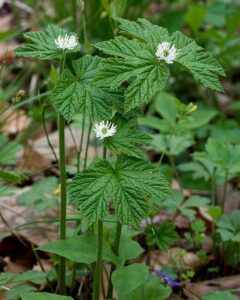
Photo by Eric Hunt, CC BY-SA 4.0, via Wikimedia Commons
Goldenseal was used by the Native Americans as a treatment for irritations and inflammation of the mucous membranes of the respiratory, digestive, and urinary tracts. It was commonly used topically for skin and eye infections. Because of its antimicrobial activity, goldenseal has a long history of use for infectious diarrhea, upper respiratory tract infections, and vaginal infections. Goldenseal is often recommended in combination with echinacea for the treatment of colds and flu. Goldenseal was considered a critical remedy for stomach and intestinal problems of all kinds by turn-of-the-century physicians called the Eclectics.
Constituents:
The two primary alkaloids in goldenseal are hydrastine and berberine, along with smaller amounts of canadine. Little research has been done with goldenseal itself. Berberine, which ranges from 0.5–6.0% of the alkaloids present in goldenseal root and rhizome, has been the most extensively researched.
It appears to have a wide spectrum of antibiotic activity against pathogens, such as Chlamydia species, E. coli, Salmonella typhi, and Entamoeba histolytica. Human studies have used isolated berberine to treat diarrhea and gastroenteritis with good results. The whole root has not been clinically studied.
The Goldenseal Plant:
aka Hydrastis canadensis, it is native to eastern North America and is cultivated in Oregon and Washington. It is seriously threatened by overharvesting in the wild. The dried root and rhizome are used.
Dosage:
Powdered goldenseal root and rhizome can be used in the amount of 4–6 grams per day in tablet or capsule form. For liquid herbal extracts, 2–4 ml three times per day are used. Standardized extracts supplying 8–1,290 alkaloids are available. Recommended dose is 250–500 mg three times per day. Continuous use should not exceed three weeks, with a break of at least two weeks between use. The powder, as a tea or tincture ,may soothe a sore throat.
Precautions:
Taken as recommended, it is generally safe. However, as with all alkaloid-containing plants, high amounts may lead to gastrointestinal distress and possible nervous system effects. Despite some traditional reports, it is not a substitute for antibiotics. Certain medications interact in a positive and/or negative way.
You may also be interested in Echinacea
